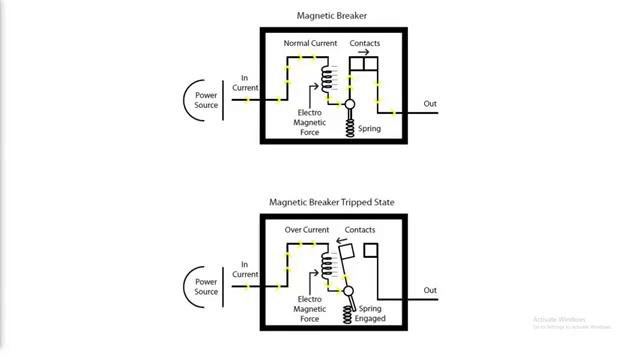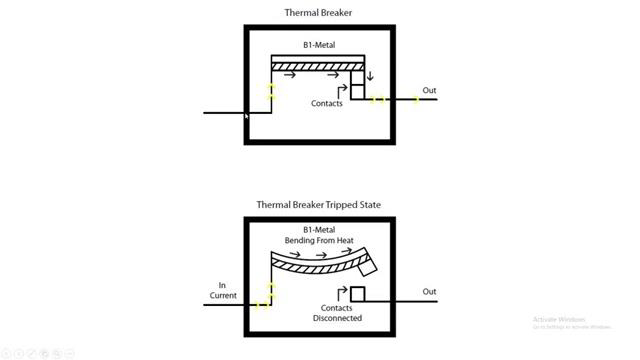The circuit breaker is an absolutely essential device in the modern world, and one of the most important safety mechanisms in your home.
Whenever electrical wiring in a building has too much current flowing through it, these simple machines cut the power until somebody can fix the problem.
Without circuit breakers (or the alternative, fuses), household electricity would be impractical because of the potential for fires and other mayhem resulting from simple wiring problems and equipment failures. In this article, we'll demonstrate how circuit breakers and fuses monitor electrical current and how they cut off the power when current levels get too high. As we'll see, the circuit breaker is an incredibly simple solution to a potentially deadly problem.
The simplest circuit protection device is the fuse. A fuse is just a thin wire, enclosed in a casing, that plugs into the circuit. When a circuit is closed, all charge flows through the fuse wire -- the fuse experiences the same current as any other point along the circuit. The fuse is designed to disintegrate when it heats up above a certain level -- if the current climbs too high, it burns up the wire. Destroying the fuse opens the circuit before the excess current can damage the building wiring.
The problem with fuses is they only work once. Every time you blow a fuse, you have to replace it with a new one. A circuit breaker does the same thing as a fuse -- it opens a circuit as soon as current climbs to unsafe levels -- but you can use it over and over again.
The basic circuit breaker consists of a simple switch, connected to either a bimetallic strip or an electromagnet. The diagram below shows a typical electromagnet design. The hot wire in the circuit connects to the two ends of the switch. When the switch is flipped to the on position, electricity can flow from the bottom terminal, through the electromagnet, up to the moving contact, across to the stationary contact and out to the upper terminal.
The electricity magnetizes the electromagnet. Increasing current boosts the electromagnet's magnetic force, and decreasing current lowers the magnetism. When the current jumps to unsafe levels, the electromagnet is strong enough to pull down a metal lever connected to the switch linkage. The entire linkage shifts, tilting the moving contact away from the stationary contact to break the circuit. The electricity shuts off.
Circuits breakers are one of the most important electrical devices in the world today. Whenever too much current is flowing through a device in our homes, places of work or industrial buildings these devices can cut power to avoid problems such as fire, electrocution. Without this protection it would be very difficult to prevent problems from consistently happening.
In todays video we want to talk about how circuit breakers can monitor electrical current and how the can disconnect power when the current gets too high. Fuse verses breakers: Fuses provide the same kind of protection, but in a different way. When too much current flows through the fuse, they are designed to blow in order to interrupt electrical flow. Problem – you can only use them once, and then they must be replaced. Breakers can be used over and over while provided the same type of protection that a fuse will. They consist of a switch connected to a bimetal strip or an electro magnet. Two different types of technology commonly seen in breakers, Magnetic and thermal protection.
Both work well, but have specific functions they excel in.
- Magnetic – Better for detecting and reacting to a short circuit. Extreme spikes in current or voltage. Current passes through the electromagnet coils so the electromagnet pulls the contact open, thus disconnecting power.
- Thermal – Provides protection against prolonged overcurrent. Uses a bimetal strip that will heat and bend and engage the trip bar which will disconnect power.
- Thermal-Magnetic – Thermal-magnetic breakers are often employed where it is important to quickly limit short-circuit current. They contain two different switching mechanisms, a bimetal switch and an electromagnet. The bimetal serves as a means of handling overcurrents. Electrical current exceeding the breaker-overload rating heats the bimetal enough to bend it toward the trip bar.
Transcript:
[0m:4s] Hi I'm Josh Bloom, welcome to another video in the RSP education series. Today we're going to be talking about circuit breakers. Circuit breakers are one of the most important electrical devices in the world today. When too much current passes through a device in our homes, place of work, or industrial building, the circuit breaker allows us to cut power to that device in order to prevent problems such as fire, electrocution, et cetera. Without these devices, it would be very difficult to protect these types of accidents from happening, and that is why they're so critical to our electrical systems. More specifically, in today's video we want to talk about how Breakers can monitor current that runs through a device, and how it can actually disconnect that power, and how that actually works. The main difference between a fuse and a circuit breaker is a fuse is intended to be used one time. Electricity passes through the fuse when the current exceeds whatever that fuse is rated for, it will blow. A circuit breaker much like diffuse will have current pass through. When current exceeds what the circuit breaker is rated for that breaker will trip. Again, the difference being that the circuit breaker can be reset and used over and over again.
[1m:9s] There are two different types of technologies that are commonly used in circuit breakers. The first is a magnetic breaker, the second is a thermal breaker. Let's first talk about the magnetic breaker and why we use that type of technology. Magnetic Breakers are better to reacting to short circuits or sharp spikes in voltage and current to quickly help trip the breaker. Let me demonstrate how this works. As you can see here, this is where we have power coming into our circuit breaker. That power then goes through this electrical coil which we refer to as an electromagnet,

[1m:40s] and then through this set of contacts,
[1m:42s] and then out to our device.
[1m:45s] The way this breaker actually works is the more current that passes through this electromagnet, the stronger this magnet becomes. When the current exceeds the rating for that particular breaker the magnetic force becomes strong enough that it will pull this contact back and disconnect it from the other contact, thus disconnecting power from our device.
[2m:5s] The next type of circuit breaker technology we want to talk about is thermal protection.
[2m:9s] The main reason we have thermal protection in a circuit breaker is to protect us against a sustained overcurrent, or a higher current for a longer period of time that can heat up our devices or wire and cause an accident such as a fire or electrocution. Thermal protection uses a Bimetal strip

[2m:38s] and then over a Bimetal strip. The Bimetal strip there's two pieces of metal that reacts differently to the current that passes through them.
[2m:45s] Over time, as we see sustained over current,
[2m:49s] that Bimetal strip will slowly start to bend, pushing the contacts away from each other disconnecting power. Now, that we've talked about the two different types of technology commonly seen in circuit breakers, we're going to talk about a thermal magnetic breaker.
[3m:1s] These are the most common type of Breakers that we'll see in our homes, places of work, and industrial applications.
[3m:8s] These Breakers combine both of those technologies, so we have the magnetic technology to protect us against short circuits or quick spikes and current or voltage, and we have the thermal technology that protects us against sustained over current over a long period of time. For a full line of circuit breakers and fuses, please go to RSP Supply’s website.
[3m:27s] For more information or other educational videos, please go to RSPSupply.com, the Internet's top source for industrial hardware.
[3m:34s] And please don't forget to like and subscribe.


